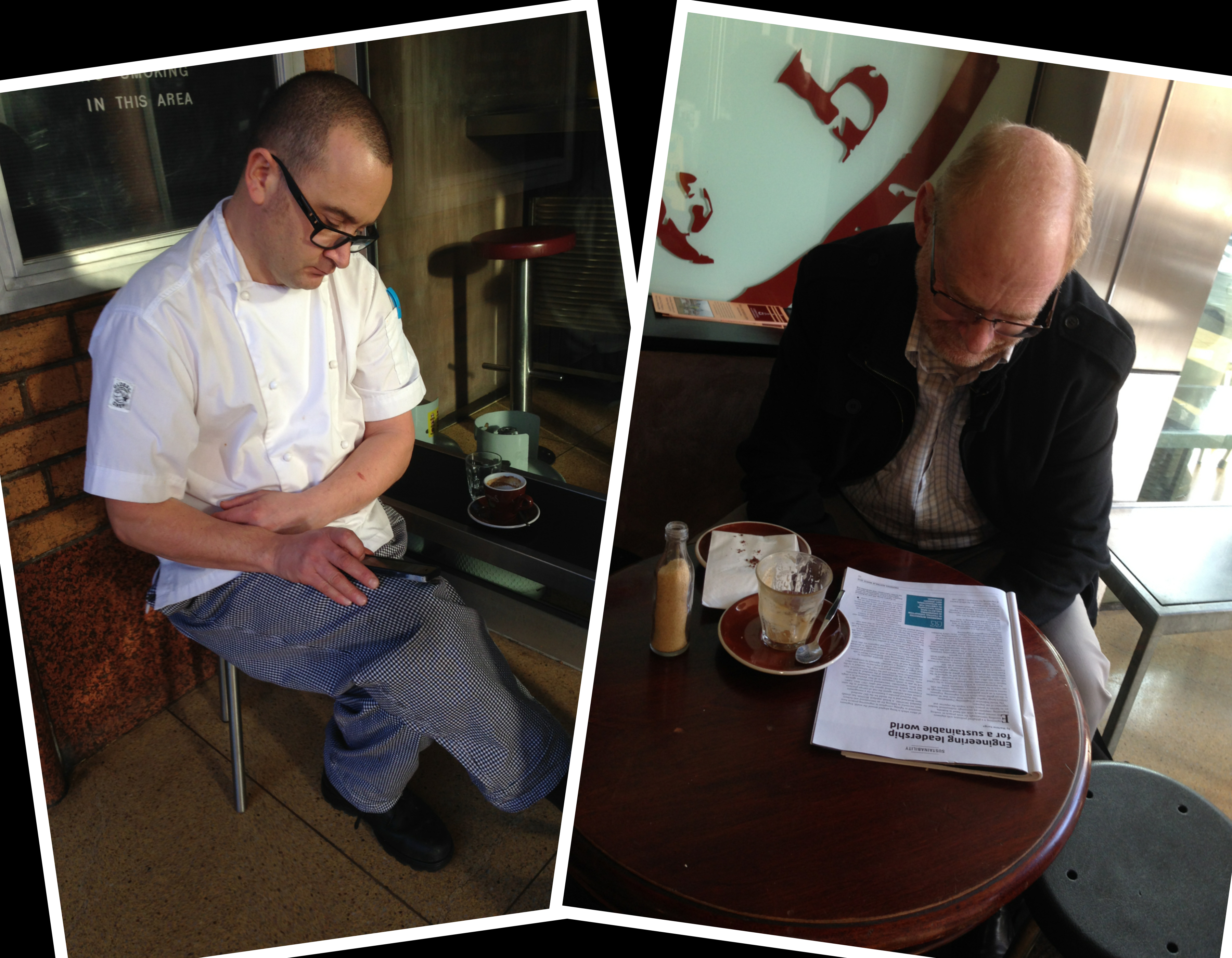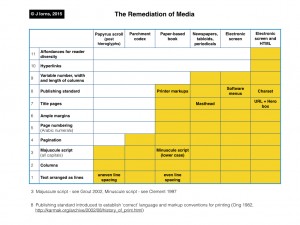Putting technological innovation into perspective: expectations, standards & forms, and norms
Expectations
Ever since the papyrus roll, readers have had expectations of their reading spaces. When you opened this space, you likely expected to see a headline, a balance of text and white space, paragraphs, hyperlinks, a picture or movie. You expected your reading space to be malleable, i.e. to zoom, copy and paste, share, hyperlink, and so forth. Writers also have expectations of their writing spaces. For instance, I expected to use WYSIWYG to write this text. I expected tools to delete and hide the text if I so chose – in other words a malleable writing space. Such reader and writer expectations of malleable spaces is a feature of the ‘fluidity’ of digital media.
Before fluidity. For five centuries, printing presses produced non-malleable and permanent reading spaces. They were copied by hand. The writer couldn’t alter the reading space after it was published, only reprint a new reading space. Once personal computers and word processor software became available, writing spaces were malleable. However, reading spaces remained permanent. Even with desk-top publishing alongside offset printing, reading spaces remained fixed.
Fluidity. With the arrival of the internet, browsers and web publishing software, the writing space and the publishing space became one, and both reading spaces and writing spaces became malleable. Technology advancements have altered the affordances of reading and writing spaces, and those affordances have in turn altered reader and writer expectations of spaces.
Standards and Forms
With the mechanisation and digitisation revolutions (the ‘industrial age’ and ‘information age’ respectively), readers have benefited from more portable spaces and increasingly legible text forms (Grout 2002, Ong 1982). Legibility comes from three things:
- changes in the type of media used to produce texts (papyrus to codex, codex to book, book to newspaper, book and newspaper to electronic screen)
- changes to text form as each new medium is adopted, and
- the introduction of publishing standards.
Study the diagram below and you will see evidence of what Bolter (2001) called ‘remediation’, i.e. when each new medium improves on the form of the old. [Click on the image to enlarge.] Identify the different media, how text forms changed with each medium, and where publishing standards came into being.
Changes to media and changes to formatting of text, together with the institutionalisation of publishing standards introduced during the printing era and continued in the digital era, have made reading progressively easier. When a reader views text on an electronic screen and uses the affordances of their browser to change text appearance, the text becomes even more legible. The more legible text is, the faster ‘silent reading’ is (Ong, 1982, p. 120). So, all the changes to media and to technologies for reading media have progressively made reading easier and faster. These days we expect reading to be easy. We expect to easily identify one reading space from another (a title page, a masthead, a URL). We expect to locate particular sections within a reading space (navigation). We expect publishers (including self-publishers) to use standards.
Norms
There has been no more radical change to Western society than when the moveable type printing press was introduced in the 15th century. Ong cited Eisenstein’s long list of the vast social effects of the printing revolution: “…. print made the Italian Renaissance a permanent European Renaissance … it implemented the Protestant Reformation and reoriented Catholic religious practice … it affected the development of modern capitalism, implemented western European exploration of the globe, changed family life and politics, diffused knowledge as never before, made universal literacy a serious objective, made possible the rise of modern sciences, and otherwise altered social and intellectual life” (1982, p. 115)
Another shift is occurring with the information age. Information passes more freely between writers and readers. There is less ‘commodity of words’ because publishing is not necessarily commercial. Indeed we now have ‘open education’ and self-publishing. Despite the positive outcomes, there are also negative norms, such as a risk of compromised personal identity when one’s personal information is accessible online, and the difficulty of maintaining copyright over a published work.
The other change I see occurring is with writer predictions of reader experience. Whereas a writer of a text in the print era could “determine the exact words that the reader would generate from the text” (Ong, 1982, p. 83), a writer publishing in the digital era can only begin to imagine what the reader sees and does with a malleable reading space.
References
Bolter, J.D. (2001). Writing space: Computers, hypertext, and the remediation of print (2nd Ed.). Mahwah, N.J.: Lawrence Erlbaum
Clement, R. W. (1997). The Online Reference Book for Medieval Studies.
Grout, J. (Ed.). (2002). Scroll and codex. In Encyclopaedia Romana. http://penelope.uchicago.edu/~grout/encyclopaedia_romana/scroll/scrollcodex.html
Jones International and Jones Digital Century. (2002). Printing: History and development. http://karmak.org/archive/2002/08/history_of_print.html
Ong, Walter. (1982.) Orality and Literacy.



Thank you for the thought-provoking post. I agree that the introduction of technology has created a fluid space for reading and, in particular, writing. Reflecting back on my education, essay writing was significantly more formal than it is today. I would start with an outline, move to a rough draft and then a final draft. I recall spending hours rewriting essays to ensure my teacher could read my printing. The thought of moving a sentence around created a substantial amount of work. The advancement of the word processor, and eventually the computer, aids in this notion of fluidity. The writing process has become less formal for me (maybe from years of post-secondary experience). Outlines and drafts are not individual components, rather the growth of one document.
On another note, after reading your comments on the expectations that reading is easier with technology, I imagine this is the case for some. I, on the other hand, struggle with reading documents on a screen. I find myself easily distracted and have issues focusing on documents longer than two pages. Many times I will print out documents for reading and find that my comprehension is increased. While researching this, I came across an article entitled, Your Paper Brain and your Kindle brain aren’t the same thing. This article argues that we use different parts of the brain when reading paper versus screens and ‘deep reading’ occurs best when reading paper. It is an interesting article and worth a quick read, even if it is ‘on screen’.
Thoughts?
Resource:
Raphael, T.J. (2014). Your paper brain and your kindle brain aren’t the same thing. Public Radio International. http://www.pri.org/stories/2014-09-18/your-paper-brain-and-your-kindle-brain-arent-same-thing
Ronaye,
Thanks for your thoughts. When you say “Outlines and drafts are not individual components, rather the growth of one document”, I totally agree!
The point I was making about easier reading is that we have make giant leaps forward in ‘legible reading’ from the all-capitals-and-no-punctuation writing of the ancients to the introduction of a table of contents and pagination (Arabic numerals), to the use of white space, sub-headings and other cues that help to focus the eye on a page/screen.
The change of habit or preference from reading printed paper to reading on an electronic screen is a reflection of something far more fundamental about human adaptability. Eventually, everyone will find reading on screen perfectly normal.